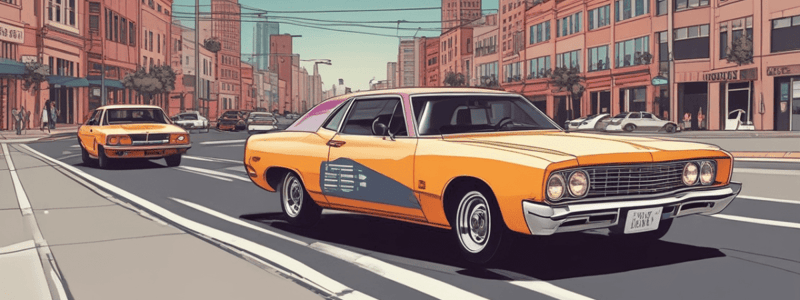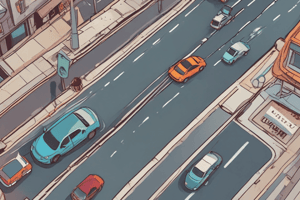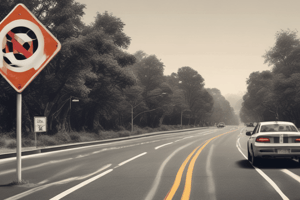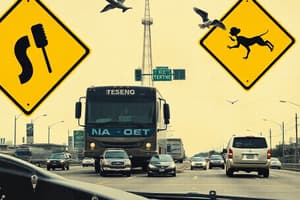Podcast
Questions and Answers
When two or more cars are traveling in the same direction, which car has the superior right-of-way?
When two or more cars are traveling in the same direction, which car has the superior right-of-way?
- The vehicle traveling at the highest speed
- The following vehicle
- The lead car (correct)
- The vehicle in the middle
What is the responsibility of the driver of a following vehicle in relation to a preceding vehicle?
What is the responsibility of the driver of a following vehicle in relation to a preceding vehicle?
- To overtake the preceding vehicle as soon as possible
- To anticipate changes of direction or speed by the preceding vehicle
- To follow as closely as possible
- To observe signals given by the driver of the lead car (correct)
Why must a driver give notice of a contemplated reduction of speed, stop, right or left turn, or change of lanes?
Why must a driver give notice of a contemplated reduction of speed, stop, right or left turn, or change of lanes?
- To obey traffic laws and regulations
- To intimidate other drivers on the road
- To avoid liability in case of an accident
- To exercise care for the safety of the cars following (correct)
What is the primary factor in determining a safe following distance?
What is the primary factor in determining a safe following distance?
What happens if a driver fails to give timely signals?
What happens if a driver fails to give timely signals?
What is a key factor in determining a safe following distance?
What is a key factor in determining a safe following distance?
Why might the driver of a following vehicle not be entirely at fault in a rear-end collision?
Why might the driver of a following vehicle not be entirely at fault in a rear-end collision?
What is a common presumption in many states regarding rear-end collisions?
What is a common presumption in many states regarding rear-end collisions?
Why might the driver of a lead vehicle be at an advantage in terms of evidence in a rear-end collision?
Why might the driver of a lead vehicle be at an advantage in terms of evidence in a rear-end collision?
What should a following driver anticipate when approaching an intersection controlled by traffic lights, a traffic officer, stop signs, or yield signs?
What should a following driver anticipate when approaching an intersection controlled by traffic lights, a traffic officer, stop signs, or yield signs?
What is the responsibility of the lead car driver when traveling in the same direction as other cars?
What is the responsibility of the lead car driver when traveling in the same direction as other cars?
What should a driver do when preparing to change lanes or reduce speed?
What should a driver do when preparing to change lanes or reduce speed?
How does a driver's duty of care towards a preceding vehicle change when signals are given?
How does a driver's duty of care towards a preceding vehicle change when signals are given?
Why does the safe following distance between vehicles vary?
Why does the safe following distance between vehicles vary?
What is the consequence of failing to give timely signals?
What is the consequence of failing to give timely signals?
In determining fault in a rear-end collision, what is a crucial factor to consider?
In determining fault in a rear-end collision, what is a crucial factor to consider?
What is the primary responsibility of the driver of a lead vehicle?
What is the primary responsibility of the driver of a lead vehicle?
What can help a following driver rebut the presumption of fault in a rear-end collision?
What can help a following driver rebut the presumption of fault in a rear-end collision?
What is a key difference in the evidence available to the drivers involved in a rear-end collision?
What is a key difference in the evidence available to the drivers involved in a rear-end collision?
What should a following driver do when approaching an intersection controlled by traffic lights or signs?
What should a following driver do when approaching an intersection controlled by traffic lights or signs?
Flashcards are hidden until you start studying
Study Notes
Rules of the Road: Moving Vehicles
- Most accidents occur between moving vehicles, and there are rules to govern different situations, including:
- Vehicles traveling in the same direction
- Vehicles traveling in opposite directions
- Passing
- Signaling
- Vehicles at intersections
Same Direction
- When two or more cars are traveling in the same direction, the lead car has the superior right-of-way and may maintain its position.
- The lead driver must exercise care for the safety of following cars and give notice of:
- Contemplated reduction of speed
- Stop
- Right or left turn
- Change of lanes
- Failure to give timely signals is considered negligence.
- The following driver must:
- Observe signals given by the lead driver
- Be prepared to avoid danger in case of properly signaled movements or reduction of speed
- Not be prepared for changes of direction or speed that are not properly signaled
Following Distance
- A driver has the duty to follow other cars at a reasonably safe distance, which may vary depending on:
- Speed of preceding vehicles
- Road conditions
- Most states have statutes that specify minimum following distances, prohibiting operators from following more closely than is "reasonable and prudent" under the circumstances.
- What constitutes a safe following distance is a question of fact, to be evaluated by considering:
- Speed of vehicles
- Road conditions
- Traffic
- Weather conditions
Rear-End Collisions
- It is a misconception that the driver of the following vehicle is always liable in a rear-end collision.
- Both the lead driver and the following driver have duties to exercise reasonable care.
- If the lead driver stops or slows without a proper signal, the following driver might not be at fault or may only be partially at fault.
- In many states, there is a rebuttable presumption that the following driver is at fault, and the following driver has the burden to provide an explanation for the cause of the collision other than their own negligence.
Lead Vehicle Driver's Perspective
- The lead vehicle driver can testify to:
- Being struck from the rear
- Their speed (if moving) or that they were stopped, why they were stopped, and where they were stopped
- The burden then shifts to the following driver to explain the cause of the accident.
Anticipating Lead Vehicle's Actions
- When a lead vehicle approaches an intersection controlled by traffic lights, a traffic officer, stop signs, or yield signs, the following driver must:
- Anticipate that the lead vehicle might slow down or stop
- Obey the traffic controls
Rules of the Road: Moving Vehicles
- Most accidents occur between moving vehicles, and there are rules to govern different situations, including:
- Vehicles traveling in the same direction
- Vehicles traveling in opposite directions
- Passing
- Signaling
- Vehicles at intersections
Same Direction
- When two or more cars are traveling in the same direction, the lead car has the superior right-of-way and may maintain its position.
- The lead driver must exercise care for the safety of following cars and give notice of:
- Contemplated reduction of speed
- Stop
- Right or left turn
- Change of lanes
- Failure to give timely signals is considered negligence.
- The following driver must:
- Observe signals given by the lead driver
- Be prepared to avoid danger in case of properly signaled movements or reduction of speed
- Not be prepared for changes of direction or speed that are not properly signaled
Following Distance
- A driver has the duty to follow other cars at a reasonably safe distance, which may vary depending on:
- Speed of preceding vehicles
- Road conditions
- Most states have statutes that specify minimum following distances, prohibiting operators from following more closely than is "reasonable and prudent" under the circumstances.
- What constitutes a safe following distance is a question of fact, to be evaluated by considering:
- Speed of vehicles
- Road conditions
- Traffic
- Weather conditions
Rear-End Collisions
- It is a misconception that the driver of the following vehicle is always liable in a rear-end collision.
- Both the lead driver and the following driver have duties to exercise reasonable care.
- If the lead driver stops or slows without a proper signal, the following driver might not be at fault or may only be partially at fault.
- In many states, there is a rebuttable presumption that the following driver is at fault, and the following driver has the burden to provide an explanation for the cause of the collision other than their own negligence.
Lead Vehicle Driver's Perspective
- The lead vehicle driver can testify to:
- Being struck from the rear
- Their speed (if moving) or that they were stopped, why they were stopped, and where they were stopped
- The burden then shifts to the following driver to explain the cause of the accident.
Anticipating Lead Vehicle's Actions
- When a lead vehicle approaches an intersection controlled by traffic lights, a traffic officer, stop signs, or yield signs, the following driver must:
- Anticipate that the lead vehicle might slow down or stop
- Obey the traffic controls
Studying That Suits You
Use AI to generate personalized quizzes and flashcards to suit your learning preferences.




